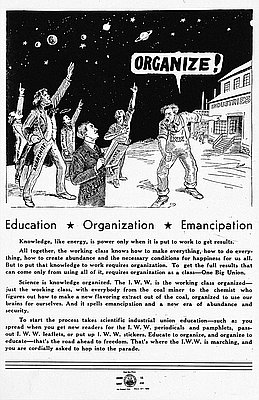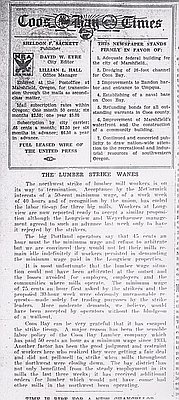- Catalog No. —
- OrHi 77731
- Date —
- 1917
- Era —
- 1881-1920 (Industrialization and Progressive Reform)
- Themes —
- Government, Law, and Politics, Labor, Trade, Business, Industry, and the Economy
- Credits —
- Oregon Historical Society
- Regions —
- Cascades Coast Northeast
- Author —
- US Army Signal Corps, Aviation Section
Loyal Legion of Loggers & Lumbermen Pledge
This “specimen” of the “Four-L Pledge” was originally devised under the leadership of the U.S. War Department’s Col. Brice P. Disque as part of a larger strategy to bring closure to a region-wide strike in the lumber industry in 1917. The strike threatened spruce production for the Allied war effort. Spruce wood is light and strong, making it ideal for airplane construction and many other wartime needs.
The Pacific Northwest lumberworkers’ strike began during the summer of 1917, spurred by the United States’ entry into World War I. After three years endurance of a depressed labor market in the lumber industry—which had given employers significant power over their workforce, labor unions were quick to capitalize on their newfound leverage during the economic upturn arising from various wartime demands. Spurred by the Industrial Workers of the World (IWW), tens of thousands of men walked off the job across the region, demanding better working and living conditions, better pay, and an eight-hour workday. By September, the striking workers were forced back to their jobs by the U.S. Justice Department’s heavy-handed repression against the IWW’s leadership and by the lack of funds to sustain the walkout. But, under the direction of the IWW, a significant number of lumberworkers continued their protest in the workplace through a “conscious withdrawal of efficiency.” This “job strike” slowed down operations considerably more in the logging camps than in the mills, but without a steady supply of logs, lumber production dropped region-wide throughout the industry.
The Department of War sent Col. Disque to Washington to investigate the causes for the region-wide dissatisfaction and resulting decrease in spruce production. Disque quickly responded by creating two organizations: the Spruce Production Division (SPD), a U.S. Army unit which put enlisted loggers and millworkers directly to work in the production of spruce products, and the Loyal Legion of Loggers and Lumbermen, or as it was commonly called, the “Four L,” a civilian equivalent of the SPD. Employers who desired the assistance of the SPD or Four L workforce were compelled by Disque and the War Department to accept the demands for an eight-hour day and healthier working and living conditions. At the same time, laborers who refused to sign the pledge found it very difficult to find employment in the lumber industry. Those who were not members of the Four L were suspected radicals, anarchists, saboteurs or traitors, and were subjected to a de facto blacklist.
Although the Four L functioned as a government sponsored labor union, its own constitution during the war years proclaimed: “The Loyal Legion of Loggers and Lumbermen is not a labor union in the common acceptance of that term, but is purely a patriotic association of both operators and operatives engaged in this essential war industry.” Membership in the locals of the Four L peaked in 1918 at approximately 110,000, but declined after the end of the war. The group reorganized in 1919 and continued to draw new members, primarily from within the mills, until it was officially ended in 1938.
Written by Joshua Binus, © Oregon Historical Society. 2003.
Related Historical Records
-
IWW Poster, Education-Organization-Emancipation
This undated organizational/promotional poster was published by the Industrial Workers of the World (IWW) in New York for distribution throughout the United States and potentially any other English-speaking …

-
The Lumber Strike Wanes
This editorial appeared in the Coos Bay Times on May 29, 1935. It describes the 1935 lumber strike, one of the largest labor strikes in Pacific Northwest history. …

